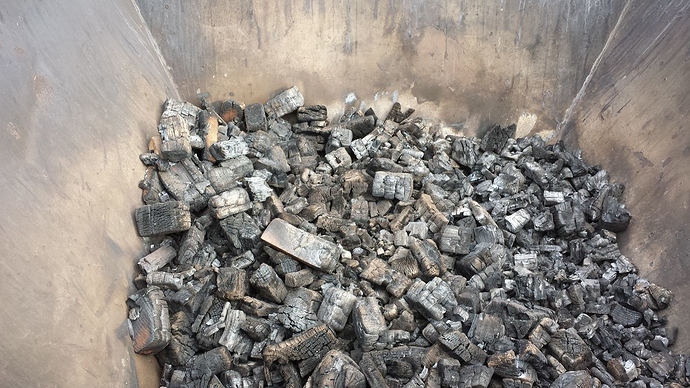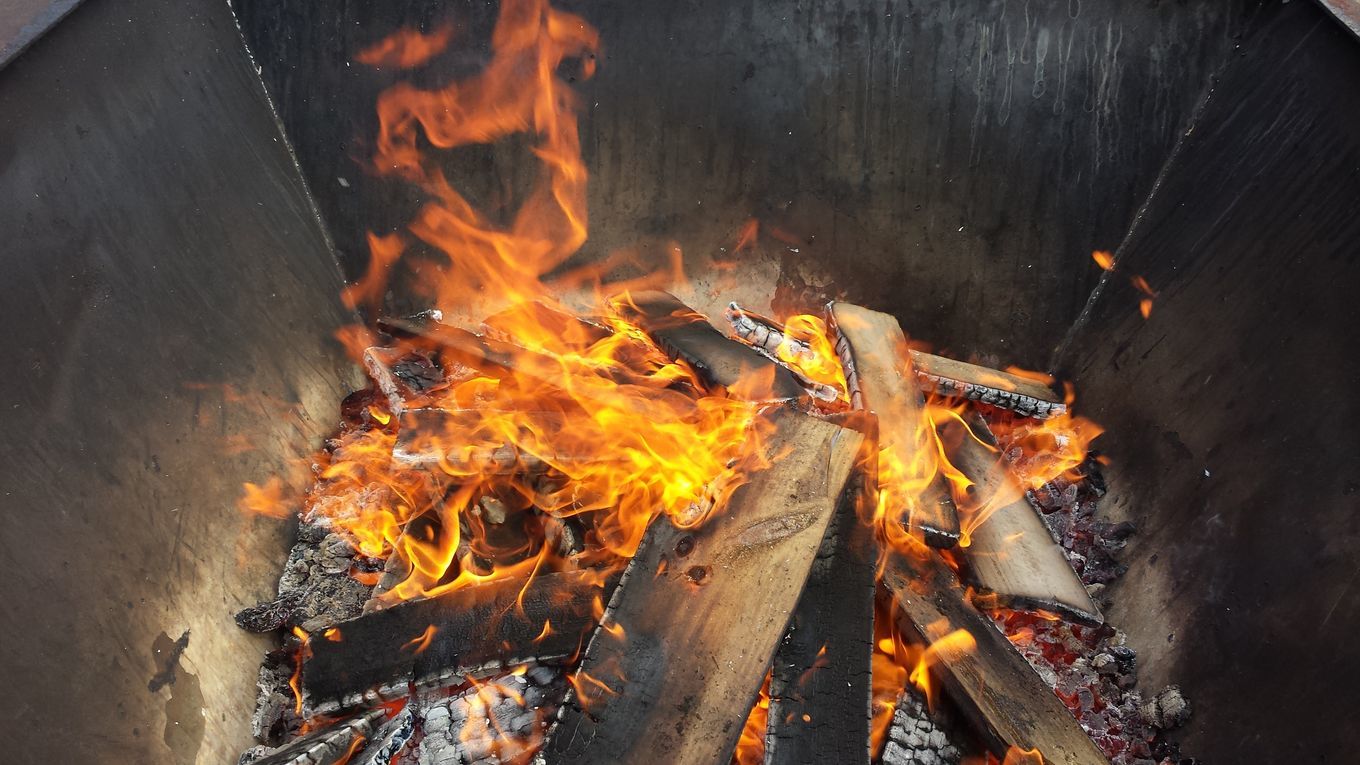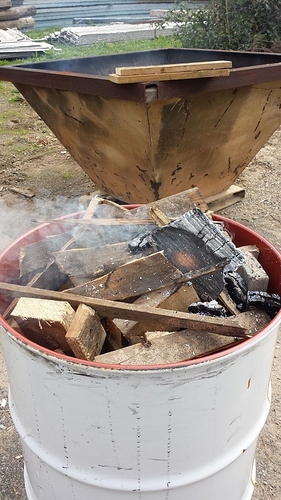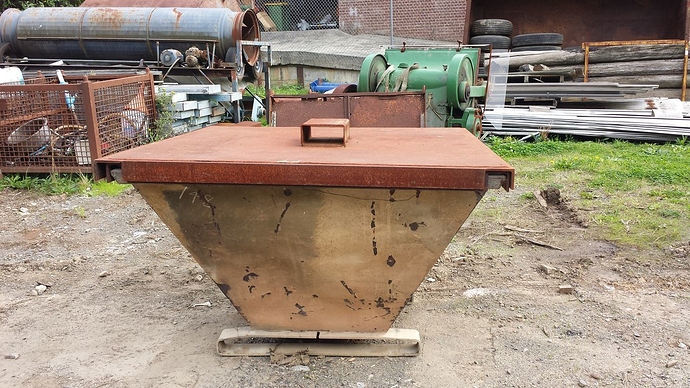Sorry about the gasoline Tom but that gives a lot of heat real quick and gets it going with almost no start up smoke I got this year’s ago from a recycle yard probably from some industrial process to use on the front of my skid steer for placing concrete.
Hey DonM my wife ran out of lighter fuid for her actual charcoal using BBQ. I pulled down her wick-type antique oil lamps that get filled with odorless lamp oil. (this hard to find expensive fuel bought by ME)
After a year or so this crystal clear stuff turns oxidization yellow.
Dumped out one of her lamps onto her lump charcoal and it worked just fine if a bit slower heating up then lighter fluid (white gasoline naphtha).
The pork chops, spring roasted asparagus’s turned out wonderful.
And one out of her six “hurricane” lamps gets new fresh oil.
Reuse, Recycle, Waste-not
Steve Unruh
I had a room mate who was an old racer and loved to barberque. He insisted on starting his charcoal with racing fuel ( ethanol ) so he didn’t get a oily taste in his meat. That was all fine But a neighbor had seen hime do it and one day when we were away he came and got the 5 gallon can and dumped it on to a fire that he had already tried to light. There were some embers in it and the alcohol blew up burning the hell out of him and burning his patio down. So I am more careful and always you diesel for a plain bond fires. Charcoal lighter for a cook out. ( yes they tried to sue me — jeers) TomC
Kyle the Hookway system is well worth trying , it is one of the most cost effective way of making charcoal and cleanly too .
The secret to it is to make sure that the barrel is very well insulated , and to have the gas outlet pipe from inside the barrel will make sure it always stays hot enough to burn off the tars so no pressure build up there .
In your picture of the wood stacked against your drum ready to burn , just one piece of that wood cut into strips would be enough to get the drum gassing .
Dave
Kyle, when you emptied your barrel, where in the barrel did you find the brands? Your barrel was fired horzontally, were your brands up front
when you opened it or in the middle of the stack? Just curious.
Jesse
Oops was thinking vertical and wrote the other
Jesse
If you decide to build a Hookway style, use a steam vent and a fan for much faster startup. I prefer horizontal with the internal flue running along the bottom. Insulate the inside of the lid for regular 55 gallon drum and there is no need for the fancy Hookway top. For an even hotter burn add my turbinator to either setup.
I built my “Hookway-esque” retort “upside-down”. The lidded opening (previously the top) is on the bottom, and the stove pipe is permanently attached through the side and top (previously the bottom of the barrel).
Load everything while the barrel is horizontal; cap it with the lid; tip it up (lid against the ground, chimney up); fire it and let it sit till cool throughout; tip it back horizontally; take the lid off and shovel/dump out the char.
I did build my insulation (sort of…) on the inside of the main barrel, thinking that it’d save the hard-to-find lidded barrels at the expense of some easy to find/otherwise unusably rusted sheet metal. I still need to find some fiberglass or something to insulate with.
nice idea… and great fuel for the car…
and for the “wasted heat” as some people tend to call things, its always possible to put a water heater on top, or build yourself something around it.
definitifly worth to do some research on possibility’s
My version of the Hookway is to have the barrel horizontal laying on 12 inches of brick , with a 6 inch pipe going through the bottom of the barrel and through the middle of the drum till about 2 inches from the lid and then a 90 degree bend up and out side the barrel , that leaves the lid free to be fastened with some springs onto the barrel for ease of filling and emptying .
The barrel and the lid are covered in chicken wire and covered with a few layers of vermiculite mixed with cement for bonding onto the chicken wire drum and lid , that then allows layers of glass insulation that wont over heat and go all crunchy for extra insulation should you need it .
A 2 foot x 1inch pipe is welded into the bottom of the drum running along the top part of the drum with as many holes along the length that you will need and coming out into the burn tube just like the hookway’s pipe does and when it starts gassing it just adds to the fire you have going in the pit below .
On the bottom of the drum I put another 90 deg bend facing down to the ground , where I dug a small pit and that’s where you start the fire using all the normal garden waste to start the burn .
A 55 gallon load takes around the 2 hours mark to completely char and once no more gassing a stopper is screwed onto that 1 inch pipe to seal it .
Today I used the cone and single updraft charcoal making containers we have , they are ok if you have to be around doing things and can keep an eye on the 55 gal while filling the cone every 15 mins or so .
The first picture was the burn from Sunday with brands on top so I came back today to finish it off
Dave
What’s the big green industrial thingy in the background of the last picture?
Dave - I did a little Internet research to try and learn about the Hookway design a few nights ago. I could not find a good description of the system. Are you aware of one?
Fired the Retort
again last night. This time, tried it with 2 55 gallon drums standing on end. Loaded the rest of the masonry structure with slab firewood.
This firing seemed to go very well. The barrels started producing gas quickly, and were still producing gas 3 hours later when I decided to go to bed. The burn seemed nice and steady.
I am optimistic that I am going to find some very good charcoal in them this morning.
If this turns out like I think, then I will stick with this method for the time being. It should yield around 70 gallons of charcoal per burn. This is more than adequate to meet our needs.
I realize that this method is not as “efficient” as the Hookway method in terms of firewood consumed. However, I am merely “rescuing” mill waste that is slated to be burned in big pits and burning it a little bit at a time (comparatively speaking) in my retort.
Jesse - It was not obvious to me where the brands were, but my best estimate is that they were near the center axis of the barrel. There were only about 3 or 4 significant “brands” (meaning larger pieces of wood that were clearly not charred and still retained shape and toughness). However, there were numerous smaller pieces - on the scale of 1 to 3 inches - that were not fully charred. This could only be discovered by hand sorting and breaking the pieces with my fingers.
Hi Kyle
You said:
“I realize that this method is not as “efficient” as the Hookway method in terms of firewood consumed.”
regardless of the method there is a lot of caloric losses
It would simply be able to recover these losses
We must work to the development of heat exchangers
I too feel guilty to issue so many “greenhouse gas” for a can of coal
Thierry
I wonder if charcoal retorts such as a Hookway would benefit from an air preheat/heat-recycling system enough to bother trying to make something.
About the only way I could see would be to make/have a larger barrel around the outside to act as a cowling to force the air to stay close to the retort skin for an extended period of time before reaching the inlet. This would either have to be lowered down over the retort or have the retort dropped down into it each time.
Another option for using waste heat is a tandem setup where the waste pyrolysis heat from retort #1 is used to fire retort #2. By changing out the inner retort and adding enough spare barrels this back and forth arrangement can be kept up continually wasting only the heat from the final batch that day.
My thoughts were more of “increasing the efficiency within the retort to minimize brands/completely charring all the wood.” Less sorting at the end.
I’ve often thought of this option. My question is this and this might be better for off topic but here goes; All of us use steel vessels which are cheap and available but why are they cheap and available if not the use of cheap coal to make steel cheap in the first place. The so called “waste” heat might be better flared then used to increase the temp of the reaction so high that it reduces the longevity of the vessel… just some thoughts.
Best regards David Baillie
Brian the large green thing is a very heavy printing press platen , and will be on its way to china in a few weeks time .
Kyle you said
you cant find a good description of the Hookway system and i may be wrong here but i believe that James Hookway was selling his plans for this system so that may explain why .
I guess you cant picture how the system i described earlier works then if your still looking for the description , sorry if i didnt explain it well enough i guess i best get some pictures sorted out of it one day .
Dave






